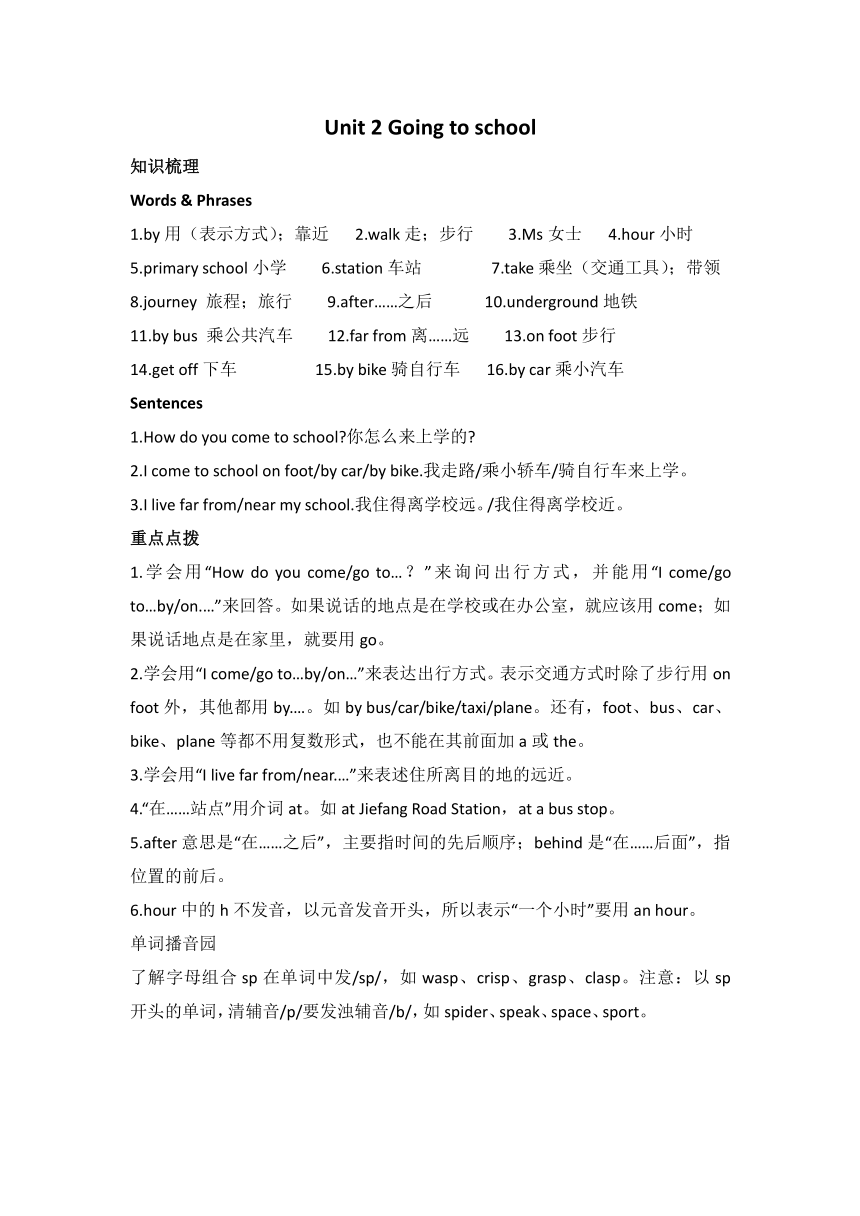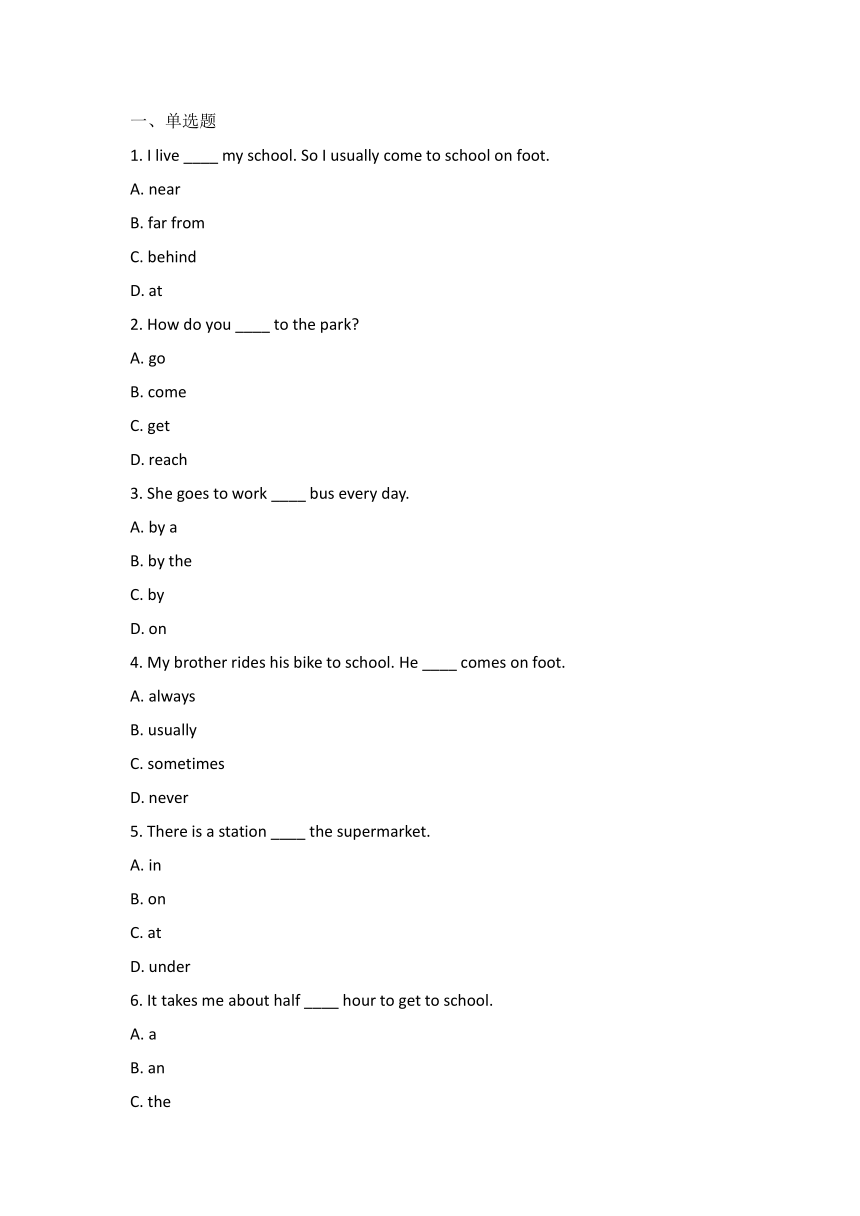Module 1 Unit 2 Going to school 知识总结及练习(含答案)
文档属性
| 名称 | Module 1 Unit 2 Going to school 知识总结及练习(含答案) |  | |
| 格式 | doc | ||
| 文件大小 | 31.0KB | ||
| 资源类型 | 教案 | ||
| 版本资源 | 牛津深圳版 | ||
| 科目 | 英语 | ||
| 更新时间 | 2024-12-30 19:07:53 | ||
图片预览


文档简介
Unit 2 Going to school
知识梳理
Words & Phrases
1.by用(表示方式);靠近 2.walk走;步行 3.Ms女士 4.hour小时
5.primary school小学 6.station车站 7.take乘坐(交通工具);带领
8.journey 旅程;旅行 9.after……之后 10.underground地铁
11.by bus 乘公共汽车 12.far from离……远 13.on foot步行
14.get off下车 15.by bike骑自行车 16.by car乘小汽车
Sentences
1.How do you come to school 你怎么来上学的
2.I come to school on foot/by car/by bike.我走路/乘小轿车/骑自行车来上学。
3.I live far from/near my school.我住得离学校远。/我住得离学校近。21·cn·jy·com
重点点拨
1.学会用“How do you come/go to…?”来询问出行方式,并能用“I come/go to…by/on.…”来回答。如果说话的地点是在学校或在办公室,就应该用come;如果说话地点是在家里,就要用go。
2.学会用“I come/go to…by/on…”来表达出行方式。表示交通方式时除了步行用on foot外,其他都用by.…。如by bus/car/bike/taxi/plane。还有,foot、bus、car、bike、plane等都不用复数形式,也不能在其前面加a或the。
3.学会用“I live far from/near.…”来表述住所离目的地的远近。
4.“在……站点”用介词at。如at Jiefang Road Station,at a bus stop。2-1-c-n-j-y
5.after意思是“在……之后”,主要指时间的先后顺序;behind是“在……后面”,指位置的前后。
6.hour中的h不发音,以元音发音开头,所以表示“一个小时”要用an hour。
单词播音园
了解字母组合sp在单词中发/sp/,如wasp、crisp、grasp、clasp。注意:以sp开头的单词,清辅音/p/要发浊辅音/b/,如spider、speak、space、sport。21cnjy.com
一、单选题
1. I live ____ my school. So I usually come to school on foot.
A. near
B. far from
C. behind
D. at
2. How do you ____ to the park
A. go
B. come
C. get
D. reach
3. She goes to work ____ bus every day.
A. by a
B. by the
C. by
D. on
4. My brother rides his bike to school. He ____ comes on foot.
A. always
B. usually
C. sometimes
D. never
5. There is a station ____ the supermarket.
A. in
B. on
C. at
D. under
6. It takes me about half ____ hour to get to school.
A. a
B. an
C. the
D. /
7. - How do you come to school - I come ____ foot.
A. in
B. by
C. on
D. with
8. They live ____ the city center. It's very convenient for them to go shopping.
A. near
B. far from
C. behind
D. between
9. The boy ____ the bus at the bus stop and then walked home.
A. got on
B. got off
C. took off
D. turned off
10. My home is ____ my school. I don't need to take the bus.
A. close to
B. far away
C. behind
D. in front of
11. She goes to the library ____ underground.
A. by an
B. by a
C. by
D. on
12. Can you tell me how ____ to the nearest post office
A. get
B. to get
C. getting
D. gets
13. He ____ to school by bike, but now he ____ taking the bus.
A. used to go; is used to
B. used to going; is used to
C. used to go; is used to go
D. used to going; is used to going
14. There is a primary school ____ our house.
A. in front of
B. in the front of
C. behind of
D. at the back of
15. After school, we often play basketball ____ an hour.
A. for
B. in
C. at
D. on
二、易错知识点及练习
1. 出行方式的表达
- 易错点:表示交通方式时,步行用on foot,其他用by + 交通工具(不用冠词),如by bus,by car等。
- 练习:选择正确的表达方式。
- I usually go to school ____ subway. (A. by B. on)
- He comes to work ____ bike. (A. by B. in)
2. come和go的用法区别
- 易错点:说话地点在学校或办公室用come,在家里用go。
- 练习:根据场景选择合适的动词。
- (At home) How do you ____ to school (A. come B. go)
- (At school) Where do you ____ from (A. come B. go)
3.hour的发音和用法
- 易错点:hour中的h不发音,以元音发音开头,表示“一个小时”用an hour。
- 练习:选择正确的单词填空。
- It takes me about ____ hour to finish my homework. (A. a B. an)
4. 介词at的用法(在站点)
- 易错点:在……站点用at,如at the bus stop,at the station。
- 练习:选择正确的介词。
- We wait for the bus ____ the bus stop. (A. at B. on)
5. after和behind的区别
- 易错点:after主要指时间先后顺序,behind指位置前后。
- 练习:根据语境选择合适的单词。
- I will do my homework ____ dinner. (A. after B. behind)
- The tree is ____ the house. (A. after B. behind)
答案1. A ,2. A,3. C,4. D,5. C,
6. B,,7. C,8. A,9. B,10. A
11. C,12. B,13. A,14. A,15. A
知识梳理
Words & Phrases
1.by用(表示方式);靠近 2.walk走;步行 3.Ms女士 4.hour小时
5.primary school小学 6.station车站 7.take乘坐(交通工具);带领
8.journey 旅程;旅行 9.after……之后 10.underground地铁
11.by bus 乘公共汽车 12.far from离……远 13.on foot步行
14.get off下车 15.by bike骑自行车 16.by car乘小汽车
Sentences
1.How do you come to school 你怎么来上学的
2.I come to school on foot/by car/by bike.我走路/乘小轿车/骑自行车来上学。
3.I live far from/near my school.我住得离学校远。/我住得离学校近。21·cn·jy·com
重点点拨
1.学会用“How do you come/go to…?”来询问出行方式,并能用“I come/go to…by/on.…”来回答。如果说话的地点是在学校或在办公室,就应该用come;如果说话地点是在家里,就要用go。
2.学会用“I come/go to…by/on…”来表达出行方式。表示交通方式时除了步行用on foot外,其他都用by.…。如by bus/car/bike/taxi/plane。还有,foot、bus、car、bike、plane等都不用复数形式,也不能在其前面加a或the。
3.学会用“I live far from/near.…”来表述住所离目的地的远近。
4.“在……站点”用介词at。如at Jiefang Road Station,at a bus stop。2-1-c-n-j-y
5.after意思是“在……之后”,主要指时间的先后顺序;behind是“在……后面”,指位置的前后。
6.hour中的h不发音,以元音发音开头,所以表示“一个小时”要用an hour。
单词播音园
了解字母组合sp在单词中发/sp/,如wasp、crisp、grasp、clasp。注意:以sp开头的单词,清辅音/p/要发浊辅音/b/,如spider、speak、space、sport。21cnjy.com
一、单选题
1. I live ____ my school. So I usually come to school on foot.
A. near
B. far from
C. behind
D. at
2. How do you ____ to the park
A. go
B. come
C. get
D. reach
3. She goes to work ____ bus every day.
A. by a
B. by the
C. by
D. on
4. My brother rides his bike to school. He ____ comes on foot.
A. always
B. usually
C. sometimes
D. never
5. There is a station ____ the supermarket.
A. in
B. on
C. at
D. under
6. It takes me about half ____ hour to get to school.
A. a
B. an
C. the
D. /
7. - How do you come to school - I come ____ foot.
A. in
B. by
C. on
D. with
8. They live ____ the city center. It's very convenient for them to go shopping.
A. near
B. far from
C. behind
D. between
9. The boy ____ the bus at the bus stop and then walked home.
A. got on
B. got off
C. took off
D. turned off
10. My home is ____ my school. I don't need to take the bus.
A. close to
B. far away
C. behind
D. in front of
11. She goes to the library ____ underground.
A. by an
B. by a
C. by
D. on
12. Can you tell me how ____ to the nearest post office
A. get
B. to get
C. getting
D. gets
13. He ____ to school by bike, but now he ____ taking the bus.
A. used to go; is used to
B. used to going; is used to
C. used to go; is used to go
D. used to going; is used to going
14. There is a primary school ____ our house.
A. in front of
B. in the front of
C. behind of
D. at the back of
15. After school, we often play basketball ____ an hour.
A. for
B. in
C. at
D. on
二、易错知识点及练习
1. 出行方式的表达
- 易错点:表示交通方式时,步行用on foot,其他用by + 交通工具(不用冠词),如by bus,by car等。
- 练习:选择正确的表达方式。
- I usually go to school ____ subway. (A. by B. on)
- He comes to work ____ bike. (A. by B. in)
2. come和go的用法区别
- 易错点:说话地点在学校或办公室用come,在家里用go。
- 练习:根据场景选择合适的动词。
- (At home) How do you ____ to school (A. come B. go)
- (At school) Where do you ____ from (A. come B. go)
3.hour的发音和用法
- 易错点:hour中的h不发音,以元音发音开头,表示“一个小时”用an hour。
- 练习:选择正确的单词填空。
- It takes me about ____ hour to finish my homework. (A. a B. an)
4. 介词at的用法(在站点)
- 易错点:在……站点用at,如at the bus stop,at the station。
- 练习:选择正确的介词。
- We wait for the bus ____ the bus stop. (A. at B. on)
5. after和behind的区别
- 易错点:after主要指时间先后顺序,behind指位置前后。
- 练习:根据语境选择合适的单词。
- I will do my homework ____ dinner. (A. after B. behind)
- The tree is ____ the house. (A. after B. behind)
答案1. A ,2. A,3. C,4. D,5. C,
6. B,,7. C,8. A,9. B,10. A
11. C,12. B,13. A,14. A,15. A
同课章节目录
- Module 1 Getting to know each othe
- Unit 1 My future
- Unit 2 Going to school
- Unit 3 My birthday
- Revision 1
- Project 1
- Module 2 Relationships
- Unit 4 Grandparents
- Unit 5 Friends
- Unit 6 Family life
- Revision 2
- Project 2
- Module 3 Out and about
- Unit 7 At the beach
- Unit 8 An outing
- Unit 9 Around the city
- Revision 3
- Project 3
- Module 4 The natural world
- Unit 10 Wind
- Unit 11 Wate
- Unit 12 Fire
- Revision 4
- Project 4
